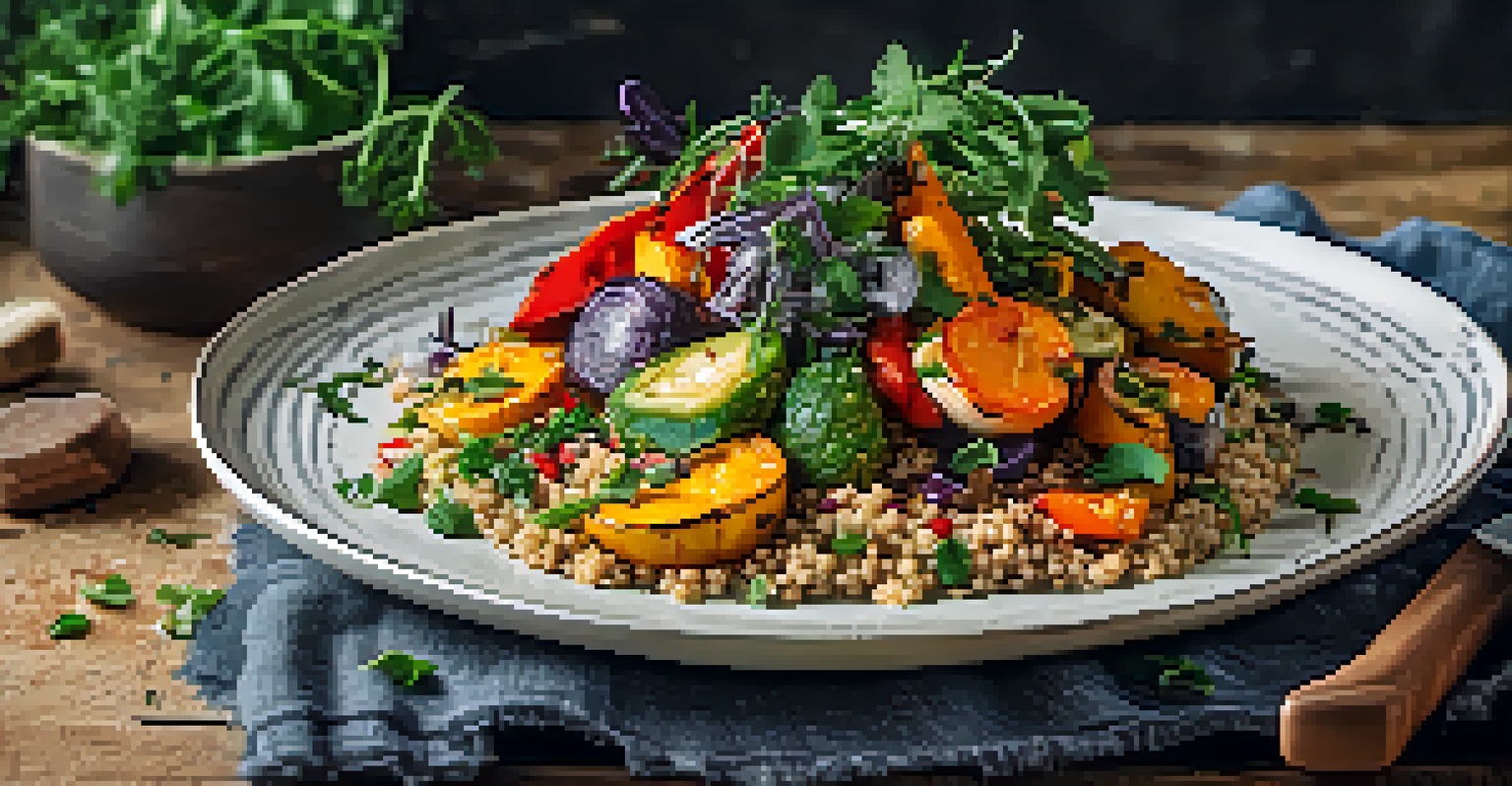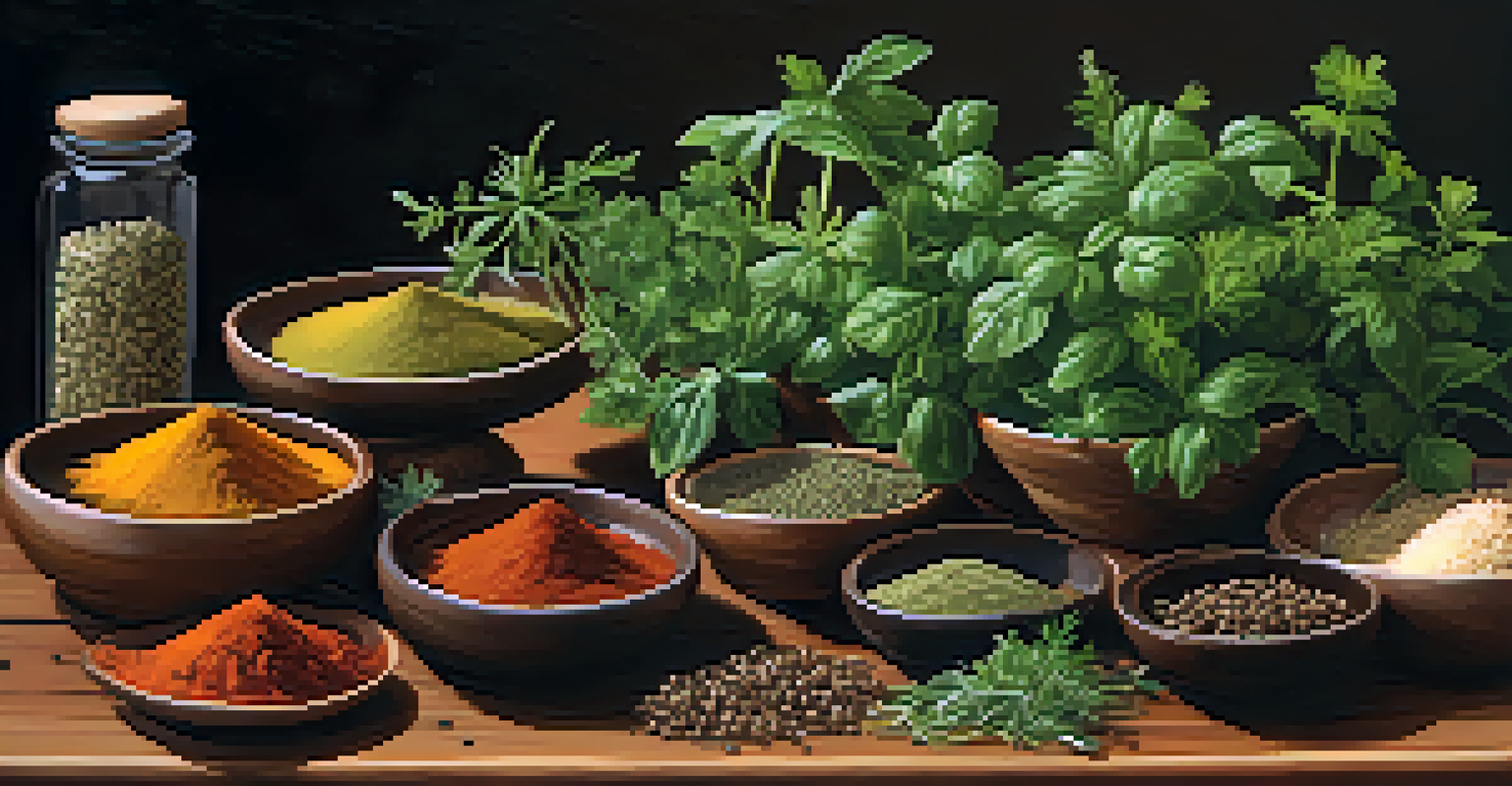Vegan Cooking 101: Tips for Beginners on Flavor Building

Understanding the Basics of Vegan Ingredients
To kick off your vegan cooking journey, it's essential to understand the different ingredients you'll be working with. Unlike traditional cooking, vegan cuisine replaces animal products with plant-based alternatives like legumes, grains, and vegetables. Familiarizing yourself with these ingredients will set a solid foundation for flavor building.
The secret of good cooking is, first, having a love of it, and second, a knowledge of it.
Each ingredient brings its own unique taste and texture to the table. For example, lentils are hearty and can mimic the texture of meat, while nutritional yeast adds a cheesy flavor without dairy. Understanding the characteristics of your ingredients is crucial for developing delicious vegan dishes.
As you explore vegan cooking, remember that variety is key. Experimenting with different combinations of ingredients can lead to delightful discoveries. Embrace the diversity of plant-based foods to elevate your culinary creations.
Harnessing the Power of Herbs and Spices
Herbs and spices are your best friends in vegan cooking, adding depth and complexity to your dishes. Fresh herbs like basil, cilantro, and parsley can brighten flavors, while dried spices such as cumin, paprika, and turmeric provide warmth and richness. Learning how to use these flavor powerhouses will greatly enhance your cooking.

Don't be afraid to experiment! Start with a pinch of a spice and gradually increase until you find the perfect balance. For instance, a dash of smoked paprika can infuse a smoky flavor into a dish, making it taste more savory and satisfying.
Understand Vegan Ingredients
Familiarizing yourself with plant-based ingredients like legumes and grains is essential for creating delicious vegan meals.
Consider creating your own spice blends to personalize your cooking. Combining spices like garlic powder, onion powder, and black pepper can yield a versatile seasoning mix that complements various dishes. The possibilities are endless, and your tastebuds will thank you.
Incorporating Umami for Richness
Umami, often described as a savory taste, is a crucial element in building flavor. In vegan cooking, you can achieve umami richness through ingredients like mushrooms, tomatoes, and fermented products like miso or soy sauce. These ingredients can transform a simple dish into a hearty meal.
Cooking is like love. It should be entered into with abandon or not at all.
For example, sautéing mushrooms until they're golden brown enhances their natural umami flavor, making them a fantastic addition to soups, stews, and sauces. Similarly, adding a splash of soy sauce or tamari can elevate your stir-fries and marinades.
Don't hesitate to think outside the box when it comes to umami. Ingredients like nutritional yeast can sprinkle that cheesy, savory flavor you might be missing. Layering these umami-rich ingredients will create a satisfying depth in your meals.
Balancing Flavors for a Well-Rounded Dish
A well-balanced dish harmonizes flavors, incorporating elements of sweetness, acidity, and saltiness. In vegan cooking, balancing these flavors can elevate your meals and make them more enjoyable. For instance, adding a squeeze of lemon juice to a rich dish can cut through the heaviness and brighten the overall taste.
Sweetness can come from natural sources like maple syrup, agave nectar, or even roasted vegetables. Caramelizing onions, for example, releases their natural sugars, creating a sweet base that enhances savory flavors.
Harness Flavor with Herbs
Using fresh herbs and spices can elevate your dishes, adding complexity and depth to your vegan cooking.
Salt is another key player in flavor balance. Using a pinch of salt can enhance the flavors of your ingredients, while too much can overpower them. Learning how to balance these flavors will help you create dishes that are not only delicious but memorable.
Experimenting with Cooking Techniques
The way you cook your ingredients can drastically change their flavor profile. Techniques such as roasting, grilling, or sautéing can bring out different tastes and textures in plant-based foods. For instance, roasting vegetables caramelizes their natural sugars, resulting in a sweet and savory dish.
Don’t shy away from trying out new cooking methods. Grilling zucchini or eggplant can impart a smoky flavor, while steaming can help retain the vibrant colors and nutritional value of your veggies. Each technique offers its own unique touch to your meals.
As you become more comfortable, think about how cooking methods can work together. For example, you might roast vegetables and then toss them into a fresh salad for added texture. Mixing techniques can keep your meals exciting and flavorful.
Building Layers of Flavor with Sauces and Marinades
Sauces and marinades are powerful tools in vegan cooking, allowing you to infuse your dishes with a burst of flavor. A good marinade can transform tofu or tempeh into a flavorful centerpiece for your meal. Think of ingredients like olive oil, vinegar, and spices to create a simple yet delicious marinade.
Experimenting with different sauces can also give your dishes a unique twist. A homemade cashew cream can serve as a rich base for pasta, while a tangy tahini dressing can elevate a simple salad to new heights. Don’t hesitate to get creative with your sauces!
Embrace Seasonal Freshness
Incorporating seasonal ingredients not only enhances flavor but also supports local farmers and keeps your meals interesting.
Moreover, layering flavors through sauces can create a depth that’s truly satisfying. Consider topping your dish with a drizzle of balsamic reduction or a sprinkle of fresh herbs to enhance the overall experience. The right sauce can be the finishing touch that ties your entire dish together.
Embracing Seasonality for Freshness
Incorporating seasonal ingredients into your vegan cooking can enhance flavor and freshness. Seasonal produce is often harvested at its peak, meaning it's more flavorful and nutritious. For instance, summer brings juicy tomatoes and crisp cucumbers, while fall introduces hearty squashes and root vegetables.
Shopping at local farmers' markets can help you discover what's in season and inspire your cooking. You might find unique varieties of vegetables and fruits that can spark your creativity in the kitchen. Embracing seasonal ingredients not only supports local farmers but also ensures that your meals are bursting with flavor.

Additionally, adapting your recipes to the seasons can keep your cooking interesting. As the weather changes, so too can your flavor profiles. Think hearty stews in winter and light salads in summer; this approach will help you make the most of what nature has to offer.